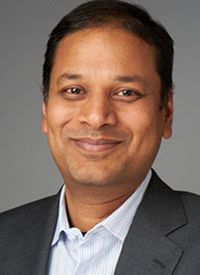Tisagenlecleucel Granted Priority Review by FDA for DLBCL
Based on results of the phase II JULIET study, a supplemental biologics license application for the CAR T-cell therapy tisagenlecleucel (Kymriah) has been granted a priority review by the FDA as a treatment for adult patients with relapsed/refractory diffuse large B-cell lymphoma who are ineligible for or relapse after autologous stem cell transplant.
Samit Hirawat

Samit Hirawat
Based on results of the phase II JULIET study, a supplemental biologics license application (sBLA) for the chimeric antigen receptor (CAR) T-cell therapy tisagenlecleucel (Kymriah) has been granted a priority review by the FDA as a treatment for adult patients with relapsed/refractory diffuse large B-cell lymphoma (DLBCL) who are ineligible for or relapse after autologous stem cell transplant (ASCT).
In the study, the CD19-directed therapy tisagenlecleucel reached an overall response rate (ORR) of 53.1% in adult patients with relapsed/refractory DLBCL.
Also based on the JULIET findings, the European Medicines Agency (EMA) has granted an accelerated assessment to a marketing authorization application (MAA) for tisagenlecleucel for the same DLBCL indication. The MAA also includes an indication for the treatment of children and young adults with relapsed/refractory B-cell acute lymphoblastic leukemia (ALL). The FDA already approved tisagenlecleucel in August 2017 for use in patients with ALL.
"The priority review designation and accelerated assessment signal that the FDA and EMA have recognized the potential of Kymriah to provide a much-needed therapeutic option for these patients with relapsed or refractory B-cell ALL and DLBCL. We are now focused on working with these regulatory agencies to bring this potentially transformative therapy to more patients,” Samit Hirawat, MD, head, Novartis Oncology Global Drug Development, said in a press release.
Patients in JULIET were enrolled at 27 study centers in 10 countries on 4 continents. At the March 8, 2017, data cutoff, 147 patients were enrolled, 99 of whom were infused with a single dose of tisagenlecleucel transduced cells (median, 3.1 x 108cells; range, 0.1-6.0 x 108). Ninety percent of patients received bridging therapy. Before infusion, patients underwent restaging and 93% received lymphodepleting chemotherapy.
The median patient age was 56 years (range, 22-76) and 77% of patients had stage III/IV disease at baseline. Forty-seven percent of patients had received ASCT. Patients had received a median of 3 (range, 1-6) prior lines of antineoplastic therapy, with 95% of patients having received at least 2 lines of therapy and 51% having received 3 or more.
The 53.1% (95% CI, 42-64;P<.0001) ORR occurred in 81 infused patients and included a complete response (CR) rate of 39.5% and a partial response (PR) rate of 13.6%. The CR rate for all 81 patients at month 3 was 32% and the PR rate was 6%. The rates were 30% and 7%, respectively, among patients evaluable at 6 months (n = 46).
The investigators observed consistent response rates across prognostic subgroups, including prior ASCT and patients with double-hit lymphoma. The median duration of response had not been reached. The probability of being relapse-free at 6 months was 73.5% (95% CI, 52.0-86.6). Among the patients achieving a CR or a PR, none proceeded to allogenic stem cell transplant or ASCT.
Median overall survival (OS) had not been reached, with the probability of OS at 6 months being 64.5% (95% CI, 51.5-74.8). Among responders, tisagenlecleucel was detected in peripheral blood by quantitative PCR for up to 367 days.
The incidence of adverse events of special interest (AESI) was evaluated in 99 patients. Common AESIs included cytokine release syndrome (CRS; 58%; grade 3, 15%; grade 4, 8%), neurological events (21%; grade 3, 8%; grade 4, 4%), prolonged cytopenia (36%; grade 3, 15%; grade 4, 12%), infections (34%; grade 3, 18%; grade 4, 2%), and febrile neutropenia (13%; grade 3, 11%; grade 4, 2%).
There were no deaths due to tisagenlecleucel, CRS, or cerebral edema. Twenty-six patients were infused as outpatients, with 20 of these patients remaining outpatients for ≥3 days after infusion.
The indication for ALL in the MAA is based on phase II results from the single-arm, international ELIANA trial of 63 patients who received a single dose of tisagenlecleucel. The targeted dose of each tisagenlecleucel infusion was 0.2 to 5.0 x 106transduced viable T cells/kg for patients ≤50 kg and 0.1 to 2.5 x 108transduced viable T cells/kg for those >50 kg.
The overall remission rate was 82.5% (95% CI, 70.9-91.0) in treated subjects. Forty patients (63%) had CR and 12 (19%) had CR with incomplete hematologic recovery.
Reference:
Schuster SJ, Bishop MR, Tam CS, et al. Primary analysis of Juliet: A global, pivotal, phase 2 trial of CTL019 in adult patients with relapsed or refractory diffuse large B-cell lymphoma. Presented at: ASH Annual Meeting and Exposition; Dec. 9-12, 2017; Atlanta. Abstract 577.
Examining the Non-Hodgkin Lymphoma Treatment Paradigm
July 15th 2022In season 3, episode 6 of Targeted Talks, Yazan Samhouri, MD, discusses the exciting new agents for the treatment of non-Hodgkin lymphoma, the clinical trials that support their use, and hopes for the future of treatment.
Listen